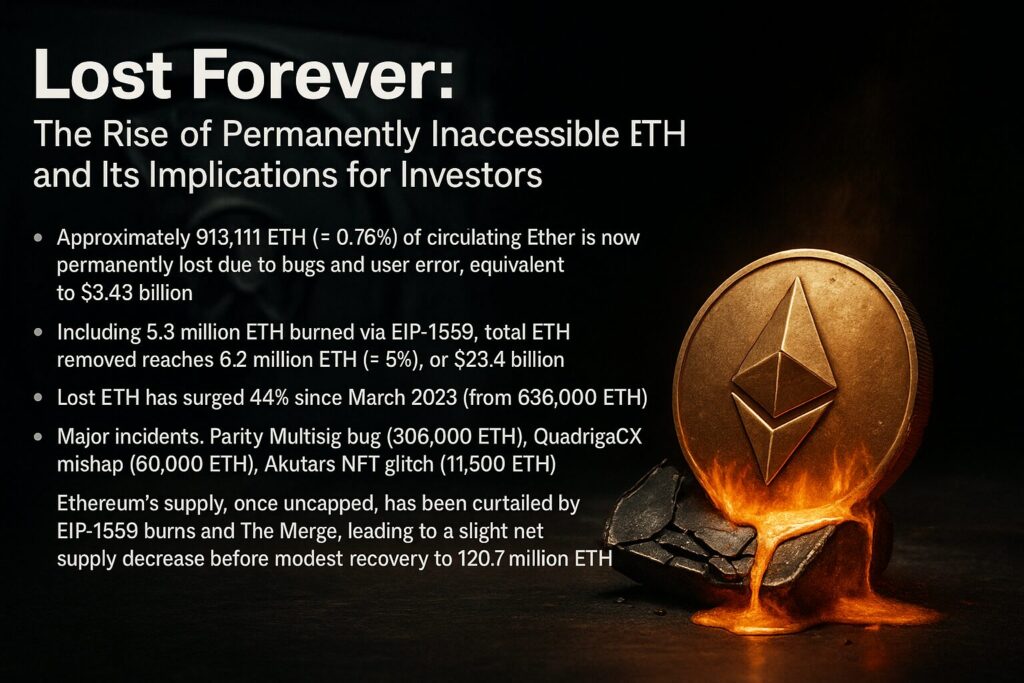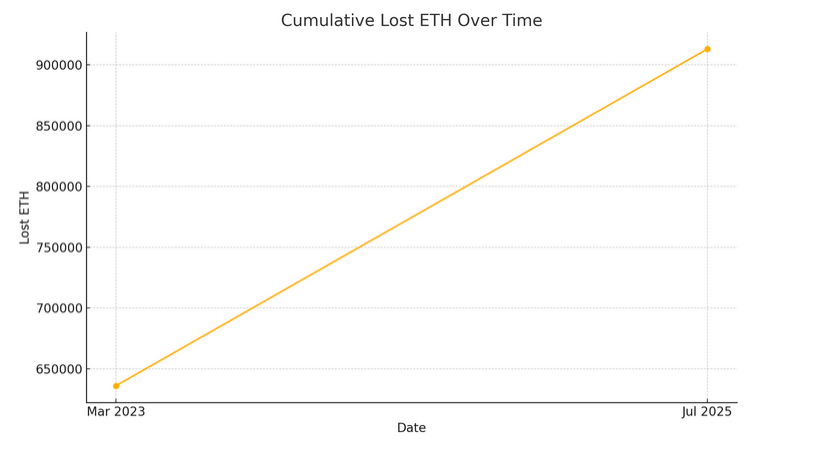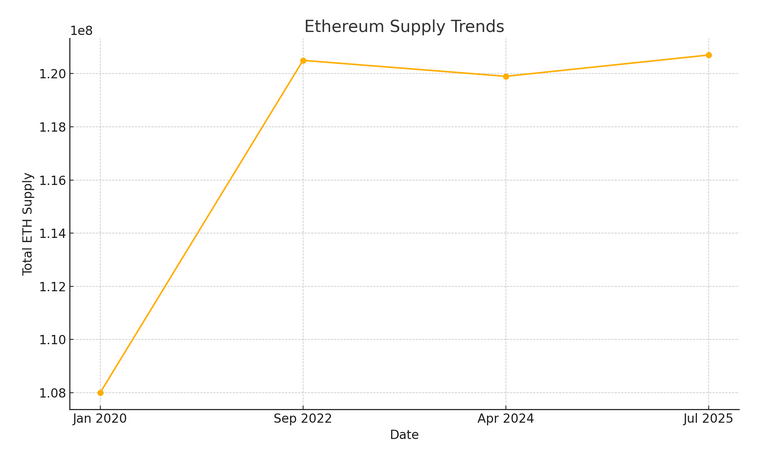
Main Points:
- Approximately 913,111 ETH (≈ 0.76%) of circulating Ether is now permanently lost due to bugs and user error, equivalent to $3.43 billion.
- Including 5.3 million ETH burned via EIP-1559, total ETH removed reaches 6.2 million ETH (≈ 5%), or $23.4 billion.
- Lost ETH has surged 44% since March 2023 (from 636,000 ETH).
- Major incidents: Parity Multisig bug (306,000 ETH), QuadrigaCX mishap (60,000 ETH), Akutars NFT glitch (11,500 ETH).
- Ethereum’s supply, once uncapped, has been curtailed by EIP-1559 burns and The Merge, leading to a slight net supply decrease before modest recovery to 120.7 million ETH.
1. The Scale of Inaccessible ETH
In mid-July 2025, Conor Grogan, Coinbase’s Head of Product, revealed that 913,111 ETH has been rendered irretrievable due to software bugs and user mistakes, now valued at $3.43 billion at prevailing prices of around $3,750 per ETH. This figure represents a substantial 0.76% of Ethereum’s circulating supply, highlighting a persistent and under‐acknowledged risk for holders.
Grogan emphasized that this estimate is conservative: it only counts tokens provably locked in faulty contracts or sent to burn addresses. It excludes countless other coins tied up in lost private keys or dormant genesis wallets, meaning the true quantity of inaccessible ETH could be far greater.
“To be clear, this $3.4 billion figure significantly undershoots the actual lost/inaccessible ETH amount — it just covers instances where Ethereum is locked forever.”
– Conor Grogan

2. EIP-1559 Burns Compound the Loss
Since the London hard fork in August 2021, Ethereum’s fee mechanism has adopted EIP-1559, automatically burning a portion of transaction fees. To date, these burns total 5.3 million ETH, removing roughly 4.4% of ever-minted supply. When combined with the 913,111 ETH lost to errors, the total permanent reduction climbs to 6.2 million ETH, or about 5% of the 120.7 million ETH current supply. In dollar terms, that’s approximately $23.4 billion irrevocably taken out of circulation.
3. Major Incidents Driving Losses
Although the overall lost figure has risen, the principal sources remain largely unchanged since the March 2023 analysis. Key events include:
- Parity Multisig Vulnerability: A flaw in the Web3 Foundation’s Parity multisignature wallet led to 306,000 ETH becoming inaccessible.
- QuadrigaCX Contract Error: The defunct Canadian exchange lost 60,000 ETH to a faulty smart contract.
- Akutars NFT Minting Glitch: Missteps during an NFT mint process destroyed 11,500 ETH.
- Burn Address Transfers: Accidental or misguided transfers to known burn addresses have added roughly 25,000 ETH.
Since March 2023, only the burn address transfers have ticked up by about 1,000 ETH, but the surge in total losses underscores the persistence of human and technical vulnerabilities.
4. Supply Dynamics: From Uncapped to Constrained
Ethereum’s supply model contrasts with Bitcoin’s 21 million cap: there is no hard ceiling on ETH issuance. Nonetheless, two pivotal upgrades have dramatically curtailed net issuance:
- EIP-1559 (Aug 2021): Introduced mandatory fee burns.
- The Merge (Sep 2022): Switched consensus from proof-of-work to proof-of-stake, slashing new issuance by over 90%.
According to YCharts data, supply grew from roughly 108 million ETH in early 2020 to 120.5 million ETH by September 2022. Post-Merge, the net supply dipped by about 0.4% (amid continued burns) through April 2024, before modestly rebounding to 120.7 million ETH by July 2025.

5. Implications for Investors and Developers
For crypto asset hunters and revenue‐seekers, these permanent losses carry several lessons:
- Security First: User education on wallet management and contract interactions is paramount.
- Smart Contract Audits: Rigorous testing and formal verification can avert costly vulnerabilities.
- Monitoring Burn Mechanics: As fees continue to burn ETH, yield strategies must account for deflationary pressure.
- Risk-Adjusted Asset Allocation: With 5% of supply effectively removed, supply-shock events can influence market dynamics.
Developers and protocol designers should continue refining UX safeguards (e.g., transaction confirmations, address whitelisting) and deploying recovery mechanisms where feasible (e.g., time-locked multisigs). Investors, meanwhile, must weigh deflationary trends and lost supply risks when evaluating long-term ETH strategies.
Conclusion
The revelation that over 913,000 ETH—worth $3.4 billion—has been lost to errors, plus 5.3 million burned, underscores the dual nature of Ethereum’s evolution: while protocol upgrades have introduced deflationary mechanics, they also magnify the impact of human and technical failures. As the network matures, a balanced emphasis on security, audit rigor, and user-friendly safeguards will be essential to minimize future losses and safeguard value for the growing community of DeFi pioneers, NFT artists, and institutional entrants.

